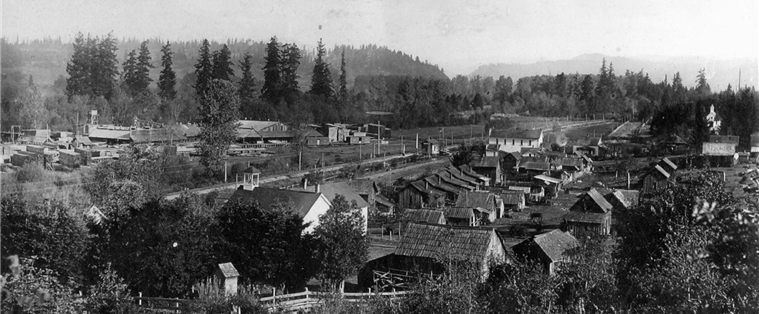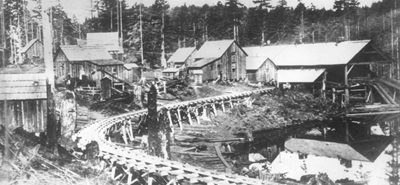Prior to homesteaders and early settlers this land was home to the Kalapuya Tribe, to read about the indigenous peoples see the mini lesson titled Local Kalapuya Bands.
Between Cottage Grove and Creswell are a few, nearly forgotten, timber towns including Saginaw, Walker, Delight Valley, and Lynx Hollow. Most driving through on highway 99 don’t really know when they’ve exited one and entered the other. Is the line just over the hill or around a corner? Here we will look at two of these towns.
Saginaw
 Saginaw started with homesteaders who crossed the country in covered wagons. With the arrival of the railroad in 1872 the town experienced a timber boom. The train stop in Saginaw saw robust commerce as settlers came from all around to get supplies and ship items out. This also become a lumber shipping location with several area sawmills sending lumber up and down the line. J.I. Jones was the first organized lumbermen of the area. He sold his timber holdings and sawmill to Booth Kelly who built up the industry. The store that remains today was originally built by Booth Kelly Lumber Company and bore the name for many years. Later years saw Rickini Lumber, Bohemia Lumber, and in more recent years Whitsell Manufacturing Mill.
Saginaw started with homesteaders who crossed the country in covered wagons. With the arrival of the railroad in 1872 the town experienced a timber boom. The train stop in Saginaw saw robust commerce as settlers came from all around to get supplies and ship items out. This also become a lumber shipping location with several area sawmills sending lumber up and down the line. J.I. Jones was the first organized lumbermen of the area. He sold his timber holdings and sawmill to Booth Kelly who built up the industry. The store that remains today was originally built by Booth Kelly Lumber Company and bore the name for many years. Later years saw Rickini Lumber, Bohemia Lumber, and in more recent years Whitsell Manufacturing Mill.
In addition to the store, Saginaw consisted of a school, a church, a bakery, post office, rows of mill houses, a lumber yard, company offices, and a planing mill and loading dock. The planing mill brough in timber that was sent down from Prune hill on the 6 to 7 mile long flume. (The flume length changed as the mill site was moved to better reach different logging sites) The Post office was established in 1898.
In her article for the Golden Was the Past book, Alice Fox wrote about the Prune Hill workers: “Men living at Saginaw road the rough lumber down the flumes on weekends, to home. The younger lumberjacks road the planks to Saginaw, hiking on into Cottage Grove to whoop it up for the night.”
Prune Hill, east of town, was one of Saginaw’s most productive lumber operations. With a sawmill, log pond, supply store, bunk house, cook house and mill shack housing, Prune Hill send rough lumber to Saginaw via the flume for processing at the mill and shipping on the railroad. Booth Kelly operated until 1914. While logging remained in the area, it would never return to its early robust operation of the late 1800’s and early 1900’s.

A new store was built in the 1950’s just a block north of the original store, and in 1921 highway 99 was built. Charles H. Sharon and Albert Woodard blasted the hill south of Saginaw to make this possible. This new highway improved road conditions, but quickly become another back road when I-5 was constructed in the late 1950’s.
Walker
Just north of Saginaw, along highway 99, is the town of Walker. This area was part of the Donation Land Claim of early settler Campbell Chrisman who arrived in the area in 1853 after traveling to Oregon in 1851 on a wagon train along the Barlow Pass Route. By the time the railroad came through in the 1870’s Chrisman had a large amount of land amassed. It took a lot of convincing to persuade Chrisman to allow the train tracks to bisec his land. Local legend says that as part of the negotiations Chrisman was granted the rights to flag down a train any time he wanted and ride to any destination and back for free for the rest of his life.
In 1855 Chrisman’s daughter Mary wed John Walker, who originally settled on the Row River, before moving to what would later be called Walker. John and Mary inherited a large portion of land in the area in 1885. By the time the post office was established in 1891 the community was known as Walker. While the post office was only in operation until 1925, the Little White Church, built in 1895, remains standing today.
Most families who called Walker home were either farmers or worked in the timber industry. Mr. Walker operated a large warehouse that stored grain for local farmers till it could be loaded on train cars and carried away. The Walker High School served students from the communities of Walker, Saginaw, Delight Valley and Lynx Hollow. There were also several motel cabins for travelers along highway 99 which went right through town.
Saginaw and Walker are two of the may Northwest towns built by timber. Their heyday may be behind them, but these who remain continue to add to the telling of the towns stories.

